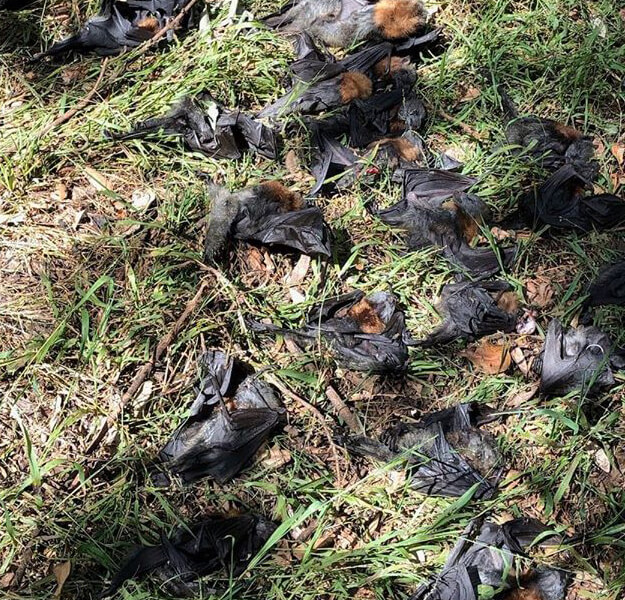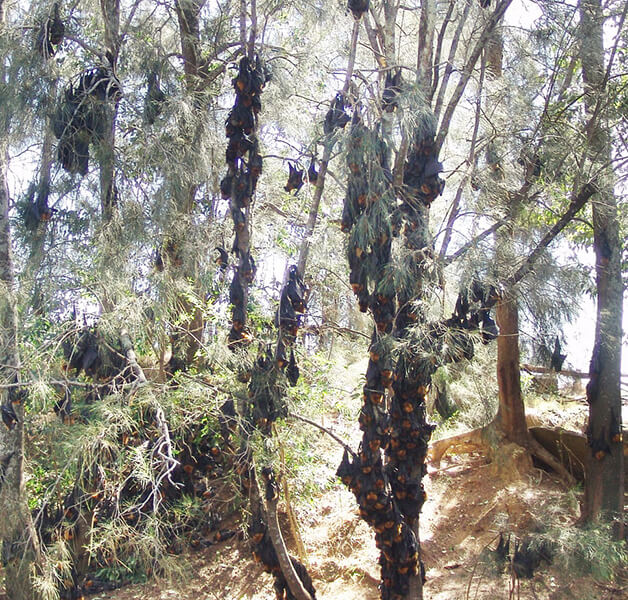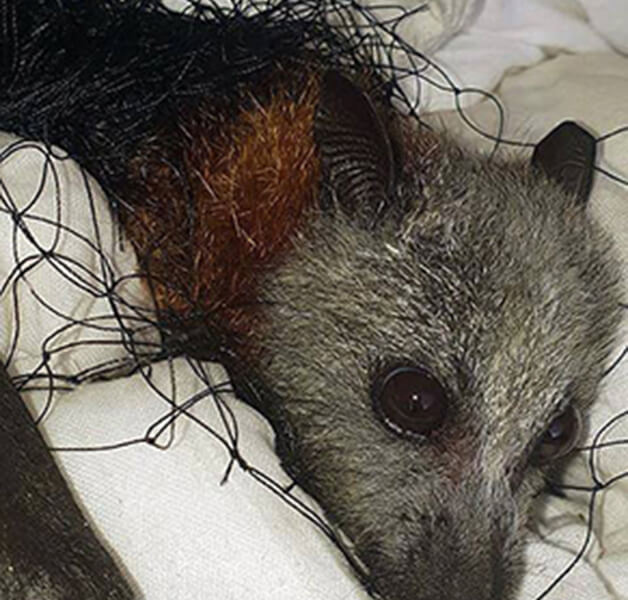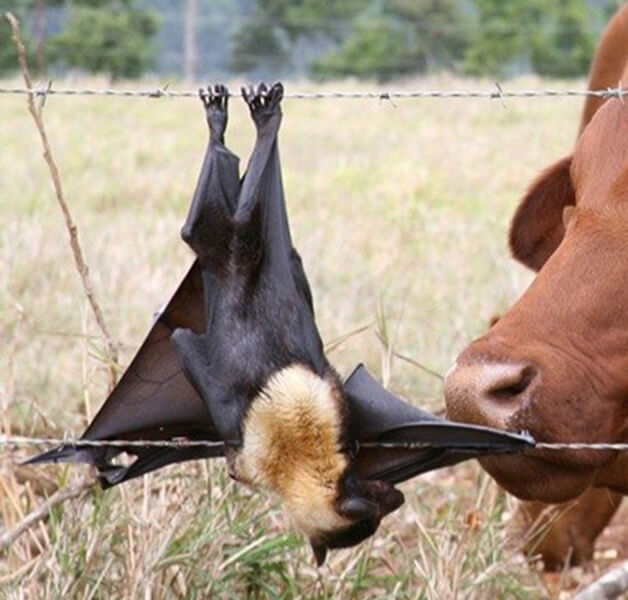Unlike other pollinators like bees and birds, flying-foxes can transport pollen over vast distances and are able to disperse larger seeds. This makes them vital to the health and regeneration of our native forests.
Threats to flying-foxes
The main threat to flying-foxes is clearing or modification of native vegetation. This removes appropriate roosting habitat and limits availability of natural food supplies. Loss of habitat and urbanisation across south-eastern Queensland and north-eastern New South Wales has seen the removal of annually reliable winter feeding sites. This process continues.
Flying-foxes are increasingly setting up camps in urban areas. This places them at risk of:
- entanglement and death in inappropriate tree netting and barbed-wire
- electrocution on powerlines
- injuries from feeding on introduced trees
- being persecuted at their camps.
The deterioration of roost vegetation, combined with an increase in heat waves, means flying-foxes are increasingly susceptible to heat stress events. Read about heat stress in flying-fox camps.
Threatened species listing
A threatened species is one that has been formally determined to be threatened with extinction in the near future. There are many factors than can influence the risk of extinction of a species and therefore its conservation status. These factors include:
- the number of individuals remaining
- overall increase or decrease in the population over time
- breeding success rates
- change in geographic distribution
- known threats.
In the case of the grey-headed flying-fox, its conservation status is based not on the numbers of animals in existence but on the rapid rate of decline in numbers over a relatively short period. Population counts of flying-foxes between 1989 and 1999–2001 suggested that the national population may have declined by up to 30 per cent.
For more detailed descriptions of national and state threatened species nomination and listing processes, visit the Australian Government Threatened Species Scientific Committee and the NSW Threatened Species Scientific Committee.
National conservation status
The grey-headed flying-fox is listed as vulnerable to extinction under the Commonwealth Environment Protection and Biodiversity Conservation Act 1999.
At the time of listing in 2001, the species was considered eligible for listing as vulnerable because estimates of the species' abundance between surveys in 1989 (566,000) and 1998–2001 (400,000) showed a rate of decline of around 30 percent.
NSW conservation status
The grey-headed flying-fox was listed as vulnerable to extinction under the Threatened Species Conservation Act 1995 in 2001. This listing was transferred to the Biodiversity Conservation Act 2016 when it came into force on 25 August 2017.
The listing was primarily based on the national population decline of around 30 percent. It was also estimated that the population would continue to decrease by at least 20 percent in the next 3 generations, given the continuation of the current rate of habitat loss and culling. A number of other factors were also considered during the listing process.
Visit the NSW Threatened Species Scientific Committee determination for more information.
Species recovery and re-evaluation
For a species to be found eligible to be removed from the threatened species list, evidence must be provided that demonstrates that the species no longer meets any of the 5 criteria for listing and is therefore not considered threatened.
Evidence must also be provided that demonstrates the removal of protection and conservation management programs would not result in the species becoming eligible for listing in the foreseeable future.
In the case of the grey-headed flying-fox, delisting would require demonstrating that the species population did not meet the criterion of population size reduction over a 10-year period. To understand whether the grey-headed flying-fox population is increasing, stable or decreasing, there is a National Flying-fox Monitoring Program. The program established a reliable benchmark for the size of flying-fox populations in 2013 and has monitored population trends since then.
The 2015 CSIRO Status and trends of Australia's EPBC-listed flying-foxes report estimated that the population of grey-headed flying-foxes has remained relatively stable, but potentially has declined slightly since 2005. Given that the known threats to the species continue to be threats and that new threats like heat stress events are emerging, the report suggests that the conservation status of the grey-headed flying-fox should at the very least remain as vulnerable.
NSW Flying-fox Consultative Committee
There is widespread community interest in flying-foxes and concern about the conservation and management of the grey-headed flying-fox.
Wildlife managers need to prevent damage to the livelihoods of horticulturists, find solutions to issues of increasing numbers of flying-fox camps in urban environments and avoid disease transmission. At the same time, they must try to protect the welfare of flying-foxes and stop further losses in flying-fox populations so that native ecosystems are maintained.
Soon after the listing of the grey-headed flying-fox as a threatened species in 2001, we established the NSW Flying-fox Consultative Committee. With representatives from key interested parties, the purpose of the committee is to provide balanced public input into the management and conservation of the 3 species of flying-foxes in New South Wales.
Members of the Flying-fox Consultative Committee include representatives from:
- BatWatch
- Commonwealth Department of Agriculture, Fisheries and Forestry
- Forestry Corporation of NSW
- Humane Society International
- Local Government NSW
- Nature Conservation Council of NSW
- NSW Department of Primary Industries and Regional Development
- NSW Farmers Association
- NSW Health
- NSW Wildlife Council
- orchardists
- scientists
- World Wildlife Fund Australia.



